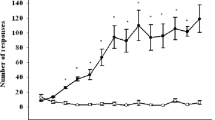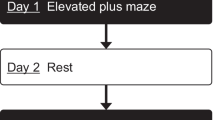Abstract
Bolus intravenous (IV) administration of commonly used IV anesthetic agents such as fentanyl and the fentanyl analogues, alfentanil, remifentanil, and sufentanil, etomidate and propofol, produced anesthesia in rats as measured by the loss of righting (LOR) with calculated ED150 doses of 0.06, 0.09, 0.037, 0.007, 2.51 and 6.12 mg/kg, respectively. Animals trained in an eight arm radial maze (RAM) were assessed for cognitive recovery, as measured by response efficiency (percentage of correct arm entries within 10 min), immediately, 15 min and 30 min following IV administration of the calculated ED150 dose of each of these agents, and the subsequent return of righting (ROR). Animals administered fentanyl or sufentanil were unable to successfully complete the maze throughout the testing periods. Animals receiving remifentanil showed cognitive recovery within the first testing interval (immediately following the return of righting), while animals receiving alfentanil, etomidate or propofol showed recovery at the 15-min testing interval following ROR. In a separate experiment, bolus IV administration of the ED150 dose of these agents was evaluated in an acute rat EEG model. Following ROR, return to baseline EEG levels occurred at 0.30, 2.88, 5.06, 16.25, 31.29 and 43.98 min for remifentanil, propofol, alfentanil, etomidate, fentanyl and sufentanil, respectively. These data show that the return to efficient cognitive functioning corresponds to the return to normal baseline EEG waveforms.
Similar content being viewed by others
References
Clotz MA, Nahata MC (1991) Drug review — clinical uses of fentanyl, sufentanil and alfentanil. Clin Pharm 10:581–593
Cockshott ID, Douglas EJ, Plummer GF, Simons PJ (1992) The pharmacokinetics of propofol in laboratory animals. Xenobiotica 22:369–375
Concas A, Santoro G, Mascia MP, Serra M, Sanna E, Biggio G (1990) The general anesthetic propofol enhances the function ofγ-aminobutyric acid coupled chloride channel in the rat cerebral cortex. J Neurochem 55:2135–2138
Davis PJ, Cook DR (1986) Clinical pharmacokinetics of the new intravenous anaesthetic agents. Clin Pharmacokinet 11:18–35
Depoortere H, Decobert M, Granger P, Riou-Merle F (1986) Hypnotics: clinical value of pharmaco-EEG methods. Neuropsychobiology 16:157–162
Doenicke A, Loffler B, Kugler J, Suttmann H, Grote B (1982) Plasma concentration and EEG after various regimens of etomidate. Br J Anaesth 54:393–400
Feldman PL, James MK, Brackeen MF, Bilotta JM, Schuster SV, Lahey AP, Lutz MW, Johnson MR, Leighton HJ (1991) Design, synthesis, and pharmacological evaluation of ultra-short- to long-acting opioid analgesics. J Med Chem 34:2202–2208
Franks NP, Lieb WR (1994) Molecular and cellular mechanisms of general anesthesia. Nature 367:607–614
Ghoneim MM, Yamada T (1977) Etomidate: a clinical and electroencephalographic comparison with thiopental. Anesth Anal [Curr Res] 56:479–485
Greenblatt DJ, Ehrenberg BL, Gunderman J, Locniskar A, Scavone JM, Harmatz JS, Shader RI (1989) Pharmacokinetic and electroencephalographic study of intravenous diazepam, midazolam, and placebo. Clin Pharmacol Ther 45:356–365
Hoffman WE, Cunningham F, James MK, Baushman VL, Albrecht RF (1993) Effects of remifentanil, a new short acting opioid, on cerebral blood flow, brain electrical activity and intracranial pressure in dogs anesthetized with isoflurane and nitrous oxide. Anesthesiology 79:107–113
Hug CC Jr, Murphy MR (1981) Tissue redistribution of fentanyl and termination of its effects in rats. Anesthesiology 55:369–375
Huidoboro-Toro J, Bleck V, Allan AM, Harris RA (1987) Neurochemical actions of anesthetic drugs on the gamma amino butyric receptor-chloride channel complex. J Pharmacol Exp Ther 242:943–949
Izquierdo I, Medina JH (1991) GABAA receptor modulation of memory: the role of endogenous benzodiazepines. TIPS 12:260–265
James MK, Feldman PL, Schuster SV, Bilotta JM, Brackeen MF, Leighton HJ (1991) Opioid receptor activity of GI 87084B, a novel ultra-short acting analgesic, in isolated tissues. J Pharmacol Exp Ther 259:712–718
Lozito RJ, La Marca S, Dunn RW, Jerussi TP (1994) Single versus multiple infusions of fentanyl analogues in a rat EEG model. Life Sci 55:1337–1342
Mandema JW, Danhof M (1992) Electroencephalogram effect measures and relationships between pharmacokinetics and pharmacodynamics of centrally acting drugs. Clin Pharmacokinet 23:191–215
Mason DFJ (1964) Hypnotics andgeneral anesthetics. In: Laurence DR, Bacharach AL (eds) Evaluation of drug activities: pharmacometics, vol. 1. Academic Press London New York pp 261–286
North RA, Williams JT, Surprenant A, Christie MJ (1987) μ andδ receptors belong to a family of receptors that are coupled to potassium channels. Proc Natl Acad Sci 84:5487–5491
Olton DS (1987) The radial arm maze a tool in behavioral pharmacology. Physiol Behav 40:793–797
Olton DS, Samuelson RJ (1976) Remembrance of places passed: spatial memory in rats. J Exp Psychol [Anim Behav] 2:97–116
Paxinos G, Watson C (1982) The rat brain in stereotactic coordinates. Academic Press, New York
Polster MR, Gray PA, O'Sullivan G, McCarthy RA, Park GR (1993) Comparison of the sedative and amnesic effects of midazolam and propofol. Br J Anaesthesia 70:612–616
Proctor WR, Mynlieff M, Dunwiddie TN (1986) Facilitatory action of etomidate and pentobarbital on recurrent inhibition in rat hippocampal pyramidal neurons. J Neurosci 6:3161–3168
Reddy RV, Moorthy T, Mattice T, Dietdoff SF, Deitch JRD (1992) An electroencephalographic comparison of effects of propofol. Electroencephalogr Clin Neurophysiol 83:162–168
Rosen M, Lunn JW (1987) Consciousness, awareness and pain in general anaesthesia. Butterworth, London Boston Durban Singapore Sydney Toronto Wellington
Scott JC, Stanski DR (1987) Decreased fentanyl and alfentanil dose requirements with age. A simultaneous pharmacokinetic and pharmacodynamic evaluation. J Pharmacol Exp Ther 240:159–166
Scott JC, Ponganis KV, Stanski DR (1985) EEG quantitation of narcotic effect: the comparative pharmacodynamics of fentanyl and alfentanil. Anesthesiology 62:234–241
Scott JC, Cooke JE, Stanski DR (1991) Electroencephalographic quantitation of opioid effect: comparative pharmacodynamics of fentanyl and sufentanil. Anesthesiology 74:34–42
Seifert HA, Blouin RT, Conard PF, Gross JB (1993) Sedative doses of propofol increase beta activity of the processed electroencephalogram. Anesth Anal 76:976–978
Shafer SL, Varvel JR (1991) Pharmacokinetics, pharmacodynamics, and rational opioid selection. Anesthesiology 74:53–63
Shyr MH, Yang CH, Kuo TBJ, Pan WHT, Tan PPC, Chan SHH (1993) Power spectral analysis of the electroencephalographic and hemodynamic correlates of propofol anesthesia in the rat: intravenous bolus administration. Neurosci Lett 153:161–164
Stanski DR (1992) Pharmacodynamic modeling of anesthetic EEG drug effects. Annu Rev Pharmacol Toxicol 32:423–447
Steriade M, Curro Dossi R, Nunez A (1991) Network modulation of a slow intrinsic oscillation of cat thalamocortical neurons implicated in sleep delta waves: cortically induced synchronization and brainstem cholinergic suppression. J Neurosci 11:3200–3217
Veselis RA, Reinsel R, Alagesan R, Heino R, Bedford RF (1991) The EEG as a monitor of midazolam amnesia: changes in power and topography as a function of amnesic state. Anesthesiology 74:866–874
Veselis RA, Reinsel R, Wronski M, Marino P, Tong WP, Bedford RF (1992) EEG and memory effects of low-dose infusions of propofol. Br J Anaesth 69:246–254
Wauquier A, Van den Broeck WA, Verheyen JL, Janssen PA (1978) Electroencephalographic study of the short-acting hypnotics etomidate and methohexital in dogs. Eur J Pharmacol 47:367–377
Author information
Authors and Affiliations
Rights and permissions
About this article
Cite this article
La Marca, S., Lozito, R.J. & Dunn, R.W. Cognitive and EEG recovery following bolus intravenous administration of anesthetic agents. Psychopharmacology 120, 426–432 (1995). https://doi.org/10.1007/BF02245814
Received:
Revised:
Issue Date:
DOI: https://doi.org/10.1007/BF02245814




